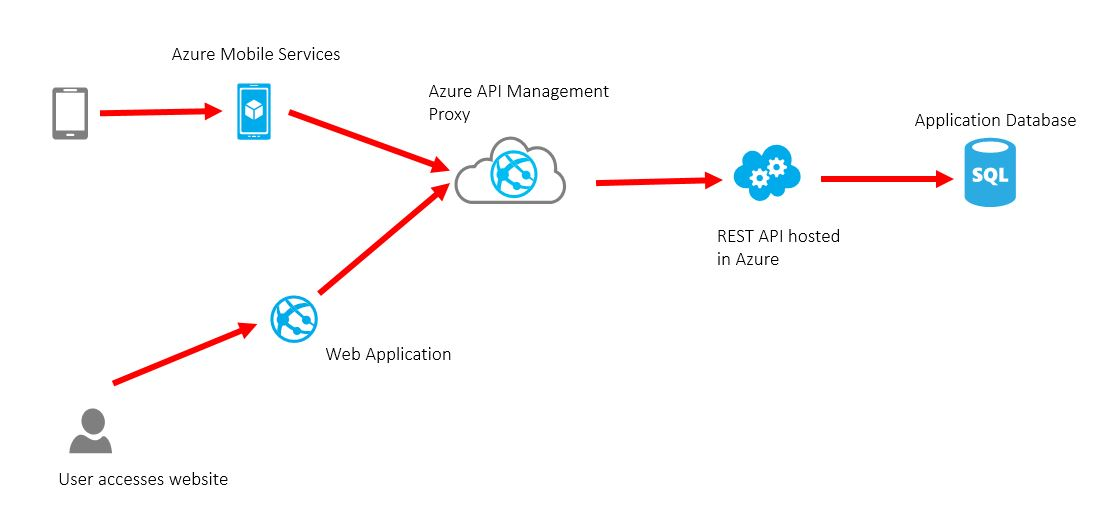- Print
- DarkLight
- PDF
This section will discuss the Azure API Management technology.
What is it?
The Azure API Management technology is an API Proxy product which is intended to sit in front of any API you create which will allow you to add some management features to your API by running calls through the API proxy. Azure API management is capable of scaling to a huge volume of calls.
API Management focuses on those features which help you to create a great experience for your API users and to help an API appear as a key business asset.
In a typical architecture diagram the role of an API Management proxy would be something like the following:

In the above diagram you can see a typical architecture where an application has been developed with a distributed REST API for its middle tier services. The application has a website which is build to service most users. In addition to this the REST API is used by a mobile application to service mobile users. In the architecture the Azure API Management proxy can be placed between the applications and the REST API to provide a way to control which applications can access the API and also provide monitoring features. In some organisations the middle tier of an application can be a very powerful interface which can be sold allowing partners to integrate with it or allow community developers to create extensions to applications. This is a bit like a Twitter example where you have the core applications which Twitter develop but also 3rd parties can develop custom interfaces and plugins which can expose Twitter data.
The API Management layer allows the organisation to have a great way to control access to their API and ensure it performs well and meets service levels.
Features
API Management offers the following features:
- Developer portal
- Business insight & analytic’s into API data
- Security & protection features
- Throttling and quotas/rate limiting to control which users can use the API to what service levels
- API grouping into products
- Administration features
- Policy injection which allows you to be able to interact with the API call and manipulate it in some way
- Caching
Strengths
The strength of the API Management tier is that it is simple to set up and get up and running but can offer some significant features to benefit your API. It is also a very competitively priced product compared to other similar products in the industry. If you are making a serious investment in API projects and in particular if your hosting your API in Azure then there is a strong case to use API Management.
Another key strength of Azure API Management offering is the recent announcement.
Weaknesses
Azure API Management used to be lacking a few features compared to some of the other vendors for APIM. In recent times I believe Microsoft has plugged this gap.
Dependencies
The API Management module has a dependency on having a subscription in the Microsoft Azure Cloud and also having an API which you can sit the management product in front of.
Hosting
The API Management product is hosted in the Microsoft Azure Cloud as a platform as a service component. This means you can leverage the cloud scale benefits of Azure but also enjoy the simple set up that PaaS offers.
Costs
The costs for API Management are very competitive and the announcement of a Serverless consumption cost model will open up APIM for the masses rather than at present where APIM is seen as an expensive and premium product.
There is also the cost model for API Management that is priced on a per unit basis. This means that you can scale by adding more API Management units to your subscription as your API usage increases. This can provide more reliable cost management.
Related Technologies
The following technologies are similar or have a relationship with API Management.
WCF Routing Service
WCF Routing Service offers a feature which sounds similar in that you can put it in front of another service as a proxy. The main difference is that WCF Routing Service is intended to implement the message routing pattern where as API Management is intended to implement features to give a better experience for your API consumers.
Product Recommendation
Learn More
The below resources will help you learn about API Management on Azure:
- Mike Stephenson: Considerations for hardening an API with Azure APIM and Azure Functions
- API Management Overview
6. Miao Jiang - API Management overview
- API Management Deepdive



